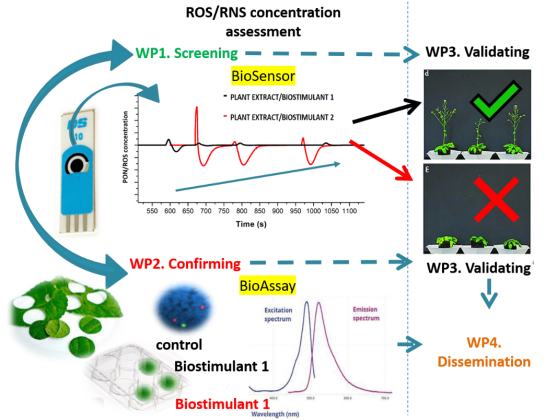Screening and designing biostimulants using electrochemical sensors and fluorescent bioassay: filling the gap between industry and science.
BioScreen
PN-III-P1-1.1-PD-2021-0798 (116PD/2022)
Biostimulants represent any substances or micro-organisms applied to plants with the aim to enhance nutrition efficiency, through improving crop yield, stimulating plant metabolism and reducing impact of external stress over the plant. Within this project we created a method that farmers, producers of plant treatments or other stakeholders could use to select, to design or to apply biostimulants, in a faster and more efficient way when compared to classical methods of evaluating biostimulant efficiency (such as optical evaluation of accumulated mass or color of the plants). The method is based on the detection of Reactive Oxygen Species (ROS), species that are responsible for oxidative stress and molecular or cellular damage, in moments when plants suffer due to external drastic conditions (such as drought, flood and heavy metal pollution, called abiotic stress; or attack of different insects or other pathogens such as bacteria and viruses, called biotic stress). The efficiency of some plant treatments (such as biostimulants, the most emerging plant treatments) is correlated to keeping under control the concentration of ROS. The determination of such species becomes essential for measuring efficiency of biostimulants.
Project goal
The aim of the BioScreen project is to screen/evaluate biostimulants with a method based on electrochemical sensors modified selectively for reactive oxygen/nitrogen species – ROS/RNS (especially peroxynitrite, PON), as these oxidative species modulate plant growth. The confirmation and the validation of this method will lead to the creation of an analytical method for the rapid and efficient selection of biostimulants, a method in line with climate change mitigation, increasing food demand, crop loss mitigation and bioeconomy.
Contracting authority: Executive Unit for Financing Higher Education, Research, Development and Innovation (UEFISCDI)
Implementation period: 15/05/2022- 31/05/2024
Budget: 250.000 lei
Project director: Dr. Chim. Ioana Silvia Hosu
Mentor: Dr. Habil. Florin Oancea
This project proposes the use of peroxynitrite selective biosensors for the screening and the selection between different biostimulant formulations, as well as the validation (mainly through fluorescent methods) and the confirmation of the selected compositions with biotests applied to grown plants (studying the resistance to salts, accumulation of biomass/secondary metabolites, enhanced photosynthesis, enhanced antioxidant protection, etc.).
The lack of a strategy in the design of biostimulants must be considered by the scientific community. Biochemical priming is one of the proposed mechanisms in the mode of action of biostimulants and involves increasing tolerance to reactive oxygen/nitrogen species (such as peroxynitrite) under conditions of both biotic and abiotic stress. Studying and screening different biostimulant compositions to scavenge these species will lead to faster and more efficient development of biostimulants.
O1. Development of screening techniques based on (bio)sensors for the detection and screening of peroxynitrite scavenging in compositions based on active ingredients generated from natural bioproducts.
O2. Evaluation of the peroxynitrite scavenging effect of the chosen composition, in plants/plant cells/plant tissues/plant extracts.
O3. Confirmation and validation of the peroxynitrite scavenging composition by bioassays.
O4. Management, dissemination and communication of project results.
Screening of the activity of some biostimulants with the ROS / RNS sensor.
Deployment period: 15/05/2022 – 31/12/2022
Activities:
- Preparation of mixtures with biostimulant potential and acquisition of a potentiostat/modular equipment/module.
- Development of ROS/RNS (bio)sensors – first part.
- Management (purchase of equipment) and dissemination (reporting, communications).
Confirmation of the activity of some biostimulants with the ROS / RNS (bio)sensor by comparison with the results of the biotests.
Deployment period: 01/01/2023 – 31/12/2023
Activities:
- Development of ROS / RNS (bio)sensors – part two.
- Biostimulant activity evaluation / screening with ROS / RNS (bio)sensors.
- Adaptation and application to plants / plant cells / plant tissues of a fluorophore-based method and comparison of results with those of ROS / RNS sensors.
- Selection of mixtures of biostimulants for plants with ROS / RNS sensor.
- Demonstration of the effects of biostimulants by biotests on plants (first part).
- Management and dissemination (Reporting, communication, patent application, 1 article submitted for publication).
Demonstration of biosensor functionality with ROS / RNS sensors in the selection of synergistic mixtures of plant biostimulants (validation of selected biostimulant mixtures).
Deployment period: 01/01/2024 – 31/05/2024
Activities:
- Demonstration of the effects of biostimulants by biotests on plants (part two)
- Management and dissemination (Reporting, 1 article submitted for publication).
– formulation of potential biostimulant mixtures for screening and selection study according to stronger biostimulant effect.
– ROS/RNS (bio)sensors developed for biostimulant screening.
– initial evaluation/screening of biostimulant compositions by methods involving of ROS/RNS (bio)sensors.
– adaptation for plants/cells/tissues/plant extracts of a fluorophore-based method for the determination of biostimulant activity.
– application of the modified fluorescent method to potential biostimulant mixtures, in order to select a synergistic biostimulant compositions.
– comparing the results of electrochemical sensors with the results of the fluorescent method.
– validation/demonstration of the effects of biostimulants by biotests, on plants (eg measurement of accumulated biomass/ assessment of increased resistance to different stress stimuli/determination of the accumulation of other molecules such as secondary metabolites, after treatment with biostimulants).
- 1 participation in an international conference presenting the development of ROS/RNS sensors.
- 1 participation in an international conference presenting biostimulant screening.
- submission of 1 patent application.
- submission of 2 manuscripts for publication in ISI quoted journals.
Scientific papers published/submitted for publication
- I.S. Hosu, M. Sobaszek, M Ficek, R. Bogdanowicz, Y. Coffinier*, Boron-doped carbon nanowalls for fast and direct detection of cytochrome C and ricin by matrix-free laser desorption/ionization mass spectrometry. Talanta (Q1, I.F.=6.1), 2023;252:123778;
- I. S. Hosu*, A. M. Baroi, R. I. Matei (Brazdis), T. Fistos, „Processes for Preparing Peroxynitrite Electrosensitive Depositions and Methods of Selective Detection for Further Biostimulant Screening”, Proceedings 2023, 90(1), 33.
- I.S.Hosu*, R.-C. Fierascu, I. Fierascu*, „Nanomaterials and nanotechnologies for electrochemical (bio)sensors: detection of important biomolecules in plants and samples related to plants, for smart and precision agriculture”. Submitted to Materials (Q1, I.F.=3.4), E-ISSN 1996-1944, Published by MDPI, submission date 31.05.2024 (manuscript ID: materials-3062584).
Scientific papers published
- I.S. Hosu, „Process for preparing peroxynitrite electrosensitive depositions and methods of selective detection”, OSIM patent application A 2023 – 00445/10.08.2023.
Participation to scientific meetings (and awards)
- I.S. Hosu*, V. Rădițoiu, A.M.V. Brânzanic, Y. Coffinier, „The influence of different metal phthalocyanines on the electroreduction of peroxynitrite for biosensing”. Poster at The International Symposium “Priorities of chemistry for a sustainable development”, PRIOCHEM XVIII, 18th Edition, 26-28th October, 2022, Bucharest, Romania.
- I.S. Hosu*, „Screening and designing biostimulants using electrochemical sensors and fluorescent bioassay: filling the gap between industry and science, PN–III–P1-1.1-PD-2021-0798”, 2023 Japan Design, Idea and Invention Expo (JDIE 2023), 6-8th July, 2023, presenting the project PN-III-P1-1.1-PD-2021-0798 (116PD/2022), for the patent application OSIM n. A2023/00445, awarded with: Certificate of Award and Silver Medal – from the invention salon.
- I.S. Hosu*, „Screening and designing biostimulants using electrochemical sensors and fluorescent bioassay: filling the gap between industry and science”, International Invention and Innovation Salon “Traian-Vuia”, 9th Edition, 15-17th June 2023, Timișoara. Romania, presenting the project PN-III-P1-1.1-PD-2021-0798 (116PD/2022), awarded with: Special Award – UPT Timisoara, Silver Medal and Diploma – from the invention salon, Gold Medal and Diploma – UPB Bucharest.
- I.S. Hosu*, „Screening and designing biostimulants using electrochemical sensors and fluorescent bioassay: filling the gap between industry and science”, European exhibition of creativity and innovation, EuroInvent, 15th Edition,, 11-1th3 Mai 2023, Iași, Romania, presenting the project PN-III-P1-1.1-PD-2021-0798 (116PD/2022), awarded with: Excellence Diploma, – from the invention salon, Excellence Trophy & Diploma – UPB, Diploma of Excellence and Gold Medal – Universitatea Ștefan cel Mare (Suceava), Diploma of Excellence and Gold Medal – Universitatea de Stat de Medicină și Farmacie “Nicolae Testemitanu” from Moldova Republic, Diploma of Excellence – “Justin Capră” Association.
- I.S. Hosu*, V. Rădițoiu, M. F. Raduly, A.-M. Baroi, I. Fierăscu, R.-C. Fierăscu, „Screening and monitoring of plant biostimulants’ efficacy for further plant utilization in pharmaceutics”, 5th International Conference on Natural Products Utilization: From Plants to Pharmacy Shelf, ICNPU-2023, 30-02nd June 2023, Constantin and Helena Saints, Bulgaria.
- I.S. Hosu*, „Process for preparing peroxynitrite electrosensitive depositions and methods of selective detection”, The International Symposium “Priorities of chemistry for a sustainable development” PRIOCHEM XIX, 19th Edition, 11-13th October, 2023, Bucharest, Romania.
- I.S. Hosu*, “Procedure for the preparation of some electrosensitive deposits for peroxynitrite and methods of using them”, 47th International Invention Show, INOVA, 26-28th September 2023, Zagreb, Croatia, presenting the patent application OSIM n. A2023/00445/10.08.2023 with the awards: Gold Medal – from the invention salon.
- I.S. Hosu*, “Procedure for the preparation of some electrosensitive deposits for peroxynitrite and methods of using them”, INVENTCOR, 4th Edition, 14-16th September 2023, Deva, Romania, presenting the patent application OSIM n. A2023/00445, awarded with: Diploma and Gold Medal – from the invention salon.
- I.S. Hosu*, V. Rădițoiu, M. F. Raduly, A.-M. Baroi, I. Fierăscu, R.-C. Fierăscu, „Screening and designing biostimulants using electrochemical sensors and fluorescent bioassay: filling the gap between industry and science”, Biostimulants World Congress, 29th November – 01st December 2023, Milano, Italy.
- I.S. Hosu*, „Procedure for the preparation of some electrosensitive deposits for peroxynitrite and methods of using them”, International Invention and Trade Expo London, 5-6th October 2023, Kingston University, Townhouse, Penrhyn Rd, Kingston upon Thames, KT1 2EQ, United Kingdom, presenting the patent application OSIM n. A2023/00445/10.08.2023, with the following awards: Gold Award – from the invention salon.
- I.S. Hosu*, „Procedure for the preparation of some electrosensitive deposits for peroxynitrite and methods of using them”, Salonul Internațional al cercetării științifice, inovării și inventicii, 21st Edition, PRO INVENT, 25-27th October 2023, Cluj Napoca, Romania, presenting the application patent OSIM n. A2023/00445/10.08.2023, with the awards: Diploma of Excellence and Gold Medal – from the invention salon.
- I.S. Hosu*, „Using electrochemical biosensors for the evaluation of plant biostimulant effect”, Workshop: New applications of materials and bioreceptors: biosensors and beyond”, Bucharest, Romania, International Center of Biodynamics (organized by Alina Vasilescu), 22nd March 2024.

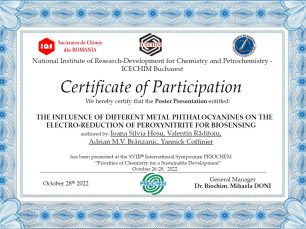
Summary
The problem that this project aims to solve is the screening (correct selection and/or optimization/design) of biostimulants for plants, since the presence on the market of some empirically developed biostimulants is in contrast to the lack of knowledge of the working mechanisms of them and creates a gap between industry and science. Plant Biostimulants (PBs) are any organism or substance applied to plants with the aim to enhance nutrient efficiency by improving the crop yields, stimulating plant metabolism or reducing impact of abiotic stress [1].
This project proposes the evaluation of plant biostimulants using a fast, efficient and accurate method based on selective sensors for reactive oxygen/nitrogen species, especially for peroxynitrite (ONOO-, PON, the structural isomer of nitrate, which behaves as a strong oxidant, similar to free radicals, although it is a very short-lived anion). The study of peroxynitrite in plants in response to abiotic stress and its role in signaling in plants is not sufficiently studied, although it is considered to play a very large role in these processes, modulating plant growth (together with other reactive oxygen/nitrogen species). The lack of knowledge is driven by the lack of rapid, accurate and sensitive methods in determining PON in plants.
Phase I of this project aims to formulate biostimulant mixtures, purchase a low current module and start ROS/RNS sensor development, as well as project management and dissemination activities. We must emphasize that the focus of this project is to develop sensors for screening biostimulants, and not the biostimulants themselves.
The formulation of biostimulants was carried with plant extracts from plants with antioxidant properties, by methods such as ultrasound, temperature and/or microwaves, as well as classic alcoholic extracts. The development of ROS/RNS sensors (Figure 2.) aims at the corresponding study of the use of different phthalocyanines as potential catalysts for the electro-reduction of peroxynitrite, for the creation of feasible sensors for the study of biostimulants and plants. The development was carried out by two methods: drop-cast and electro-polymerization of phthalocyanine solutions.
Regarding the management and dissemination activity, the following activities were carried out: participation in 1 international conference with the results presented at this stage, writing and publishing an ISI quoted article, the activity is disseminating the project through the web page and social media (Facebook and LinkedIn) and financial management of the project.
The confirmation and validation of this method will be done in the other phases of the project, which will lead to the creation of an analytical method for the rapid and efficient selection of biostimulants, a method in agreement with climate change mitigation, food demand increase, crop loss mitigation and bioeconomy. This phase was implemented and finished successfully in 2022.

Scheme of the development stages of PON sensitive sensors
No | Tracked indicator | Description of progress |
|---|---|---|
1 | Deliverables described | The deliverables from this phase were achieved: D1.1. Report: Formulation of biostimulant compositions – M5 (Activity 1.1.) D1.2. Report: Development of (bio)sensors – M8 (Activity 1.2 – activity that will be continued in Phase II). |
2 | Experimental procedure for measuring the activity of biostimulants | The procedure is described in the subsection “Development of ROS/RNS (bio)sensors (part one)” of the final scientific report. |
3 | Communication at an international conference | Participation in an international conference was achieved: 1. I.S. Hosu*, V. Rădițoiu, A.M.V. Brânzanic, Y. Coffinier, „The influence of different metal phthalocyanines on the electroreduction of peroxynitrite for biosensing”. Poster at The International Symposium “Priorities of chemistry for a sustainable development”, PRIOCHEM XVIII, 18th Edition, 26-28th October, 2022, Bucharest, Romania. |
4 | Other dissemination activities | Publication of an article in an ISI quoted journal (F.I.= 6,057):
Dissemination on the project web page:
Dissemination on social media (Facebook and Linkedin)
|
More than 10 years ago, in November 2012, the Biostimulant World Congress (BWC) took place for the use of Plant Biostimulants (PBs) in Agriculture. This congress was considered a key moment in the development of PBs. The empirical development of biostimulants created a big discrepancy between positive results obtained in plant growth with the help of PBs and the scientific knowledge of the mode/mechanism of action of the PBs, that lead to those positive results. Peroxynitrite (a powerful oxidant from the reactive oxygen species), plays an important role in obtaining these results, as it is a key plant regulator, especially in the hypersensitive response against pathogens of abiotic stress factors. Peroxynitrite is the target analyte of this project for the screening of biostimulants.
Phase II of the project consisted in confirmation of the biostimulant activity with the ROS/RNS sensor, by comparison with the biotests. In this second phase the following activities were performed: developing of the sensors (continued from Phase I), determining biostimulant activity with the electrochemical method, adapting a fluorescent method for PON detection in plants, selecting biostimulants with developed sensors and starting the activity of demonstrating the biostimulant effect on plants (Figure 3, to be continued in Phase III). Three biostimulant formulations were studied with the developed electrochemical method and compared to the biotests (during and after growth of Arabidopsis Thaliana and Vigna radiata -Mung bean seedlings, in presence and in the absence of heavy metal stress). The best biostimulant was selected for further studies of the dose in the third phase.
For management and dissemination, the following activities were realized: participation in 11 international conferences with presentation of the project and the results obtained (the indicator was 1 international conference), writing and submitting for publication of 1 ISI quoted article, submitting and applying for a patent request, dissemination through website and social media (Facebook and LinkedIn) and financial management of the project. This phase was implemented and finished successfully in 2023.
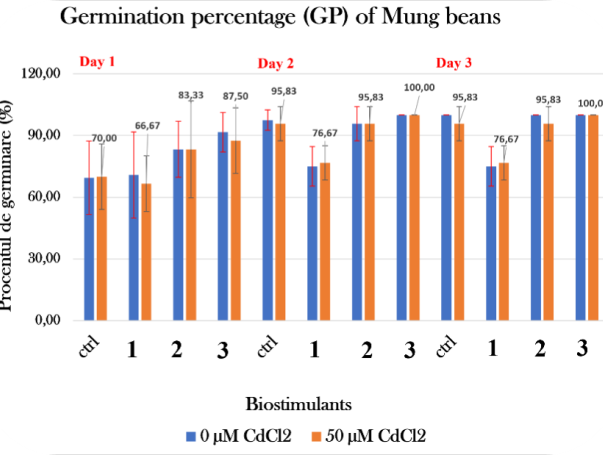
Germination percentage (GP) of Mung Beans in absence/presence of biostimulants and abiotic stress
No | Tracked indicator | Description of progress |
|---|---|---|
1 | Deliverables described | The deliverables from this phase were achieved: D1.3. Report: Screening of biostimulants with ROS/RNS (bio)sensors (Activity 2.2). D2.1. Report: Adapting fluorophore-based methods for plants/plant cells/plant tissues – M14 (Activity 2.3.) D2.2. Report: Bioassay of the biostimulants in presence and absence of stimuli – M18 (Activity 2.4. and 2.5). |
2 | 1 Experimental procedure of measuring biostimulant activity | This procedure was described in the subchapter „Dezvoltarea unor (bio)senzori ROS/RNS – partea a doua/Developing ROS/RNS (bio)sensors – second part” of the final scientific report. |
3 | 1 Biotest based on a fluorophore method for determination of biostimulant activity | The procedure is described in the subchapter “Adaptarea și aplicarea pentru plante/celule din plante/țesuturi din plante a unei metode bazate pe fluorofori și compararea rezultatelor cu cele ale senzoriilor ROS/RNS” („Adapting and applying the fluorophore-based method for plant cells/plant tissues/plants and comparison with the results obtained using ROS/RNS (bio)sensors”) of the final scientific report. |
4 | 1 report comparing the results from the fluorophore biotests with the biosensors results | The procedure is described in the subchapters “Selectarea unor amestecuri de biostimulanți pentru plante cu senzorul ROS/RNS/” și „Demonstrarea efectelor biostimulanților prin bioteste pe plante (partea întâi)/” of the final scientific report. |
1 communication at an international conference | The participation at 10 international conferences (receiving several awards): 1. I.S. Hosu, „Screening and designing biostimulants using electrochemical sensors and fluorescent bioassay: filling the gap between industry and science, PN–III–P1-1.1-PD-2021-0798”, 2023 Japan Design, Idea and Invention Expo (JDIE 2023), 6-8th July, 2023, presenting the project PN-III-P1-1.1-PD-2021-0798 (116PD/2022), for the patent application OSIM n. A2023/00445, awarded with: Certificate of Award and Silver Medal – from the invention salon. 2. I.S. Hosu, „Screening and designing biostimulants using electrochemical sensors and fluorescent bioassay: filling the gap between industry and science”, International Invention and Innovation Salon ”Traian-Vuia”, 9th Edition, 15-17th June 2023, Timișoara. Romania, presenting the project PN-III-P1-1.1-PD-2021-0798 (116PD/2022), awarded with: Special Award – UPT Timisoara, Silver Medal and Diploma – from the invention salon, Gold Medal and Diploma – UPB Bucharest. 3. I.S. Hosu, „Screening and designing biostimulants using electrochemical sensors and fluorescent bioassay: filling the gap between industry and science”, European exhibition of creativity and innovation, EuroInvent, 15th Edition,, 11-1th3 Mai 2023, Iași, Romania, presenting the project PN-III-P1-1.1-PD-2021-0798 (116PD/2022), awarded with: Excellence Diploma, – from the invention salon, Excellence Trophy & Diploma – UPB, Diploma of Excellence and Gold Medal – Universitatea Ștefan cel Mare (Suceava), Diploma of Excellence and Gold Medal – Universitatea de Stat de Medicină și Farmacie “Nicolae Testemitanu” from Moldova Republic, Diploma of Excellence – “Justin Capră” Association. 4. I.S. Hosu, V. Rădițoiu, M. F. Raduly, A.-M. Baroi, I. Fierăscu, R.-C. Fierăscu, „Screening and monitoring of plant biostimulants’ efficacy for further plant utilization in pharmaceutics”, 5th International Conference on Natural Products Utilization: From Plants to Pharmacy Shelf, ICNPU-2023, 30-02nd June 2023, Constantin and Helena Saints, Bulgaria. 5. I.S. Hosu*, „Process for preparing peroxynitrite electrosensitive depositions and methods of selective detection”, The International Symposium “Priorities of chemistry for a sustainable development” PRIOCHEM XIX, 19th Edition, 11-13th October, 2023, Bucharest, Romania. 6. I.S. Hosu*, “Procedure for the preparation of some electrosensitive deposits for peroxynitrite and methods of using them”, 47th International Invention Show, INOVA, 26-28th September 2023, Zagreb, Croatia, presenting the patent application OSIM n. A2023/00445/10.08.2023 with the awards: Gold Medal – from the invention salon. 7. I.S. Hosu*, “Procedure for the preparation of some electrosensitive deposits for peroxynitrite and methods of using them”, INVENTCOR, 4th Edition, 14-16th September 2023, Deva, Romania, presenting the patent application OSIM n. A2023/00445, awarded with: Diploma and Gold Medal – from the invention salon. 8. I.S. Hosu*, V. Rădițoiu, M. F. Raduly, A.-M. Baroi, I. Fierăscu, R.-C. Fierăscu, „Screening and designing biostimulants using electrochemical sensors and fluorescent bioassay: filling the gap between industry and science”, Biostimulants World Congress, 29th November – 01st December 2023, Milano, Italy. 9. I.S. Hosu, „Procedure for the preparation of some electrosensitive deposits for peroxynitrite and methods of using them”, International Invention and Trade Expo London, 5-6th October 2023, Kingston University, Townhouse, Penrhyn Rd, Kingston upon Thames, KT1 2EQ, United Kingdom, presenting the patent application OSIM n. A2023/00445/10.08.2023, with the following awards: Gold Award – from the invention salon. 10. I.S. Hosu, „Procedure for the preparation of some electrosensitive deposits for peroxynitrite and methods of using them”, Salonul Internațional al cercetării științifice, inovării și inventicii, 21st Edition, PRO INVENT, 25-27th October 2023, Cluj Napoca, Romania, presenting the application patent OSIM n. A2023/00445/10.08.2023, with the awards: Diploma of Excellence and Gold Medal – from the invention salon. 11. Online participation at the international conference “The International Scientific Symposium CURRENT TRENDS IN NATURAL SCIENCES”,18 – 20th May 2023, Pitești, Romania. | |
1 Patent application submitted | Ioana Silvia Hosu, „Procedee de preparare a unor depuneri electrosenzitive pentru peroxinitrit și metode de determinare selectivă a acestuia/Procedure for the preparation of some electrosensitive deposits for peroxynitrite and methods of using them”, OSIMatent application registered to with n. A 2023 – 00445 from 10.08.2023, resulted from the research contract 116PD/2022 | |
1 article submitted for publication | 1. Cournut, A.; Hosu, I.S.; Braud, F.; Moustiez, P.; Coffinier, Y.; Enjalbal, C.; Bich, C. Development of nanomaterial enabling highly sensitive surface-assisted laser desorption/ionization mass spectrometry peptide analysis. Rapid Communications in Mass Spectrometry, 2023, 37, doi:10.1002/rcm.9476. [3] 2. Hosu, I. S.; Baroi, A. M.; Matei , R. I.; Fistos, T., Processes for Preparing Peroxynitrite Electrosensitive Depositions and Methods of Selective Detection for Further Biostimulant Screening. Proceedings 2023, 90, (1), 33. [4] | |
Other dissemination activities (Activity 2.6.) | Dissemination of the project website:
| |
Dissemination of social media (Facebook and LinkedIn):
|
Usually, biochemical priming is performed before plant growth, by incubating the seeds with the biostimulants (before germination), so plants become more effective in compensating the oxidative stress effects. The positive consequence of correct biochemical priming is inducing tolerance to stress and achieve desired crop yield (Figure 4A), through the activation of the defense mechanism against future stressors (that were not yet encountered). When the primed plants encounter the stressors, when compared to the not primed ones, the efficiency of fighting against the stressor is higher. The priming can be performed with beneficial micro-organism and biological products such as humic acid, fulvic acid, chitosan etc. [5].
In this Phase III (the final phase of the project), we continued the activity called “Demonstrating biostimulant effect through biotests (second part)”, for the validation of selected biostimulant formulation. For this purpose, we took the synergic formulation selected in Phase II, and we evaluated different doses of the formulation with application on plants. The seeds were primed with 3 different doses and the same doses were used to water the in-vitro seedlings of Mung beans. We took in consideration more biotests and the results were compared with the method we developed. The extended biotests we have performed are antioxidant activity evaluation, photosynthesis yield, together with biomass accumulation and evaluation of important pigments in plants, under a different heavy metal concentration. The results of the biotests were corelated with the results obtained with the developed electrochemical method (Figure 4B).
For management and dissemination, the following activities were realized: participation in 1 international conference and 1 international workshop, with presentation of the project and the results obtained, writing and submitting for publication of 1 manuscript in ISI quoted journal, dissemination through website and social media (Facebook and LinkedIn) and financial management of the project. The BioScreen project was also promoted through an international entrepreneurship program for DeepTech, financed by European Union (more details in the indicator’s tabel). This phase was implemented and finished successfully in 2024, together with project completion.
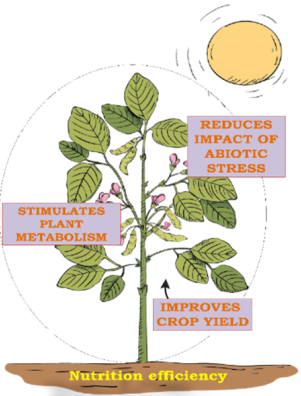
(A)
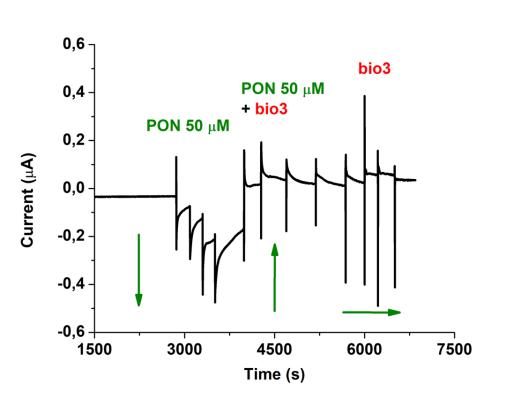
(B)
(A) Visual representation of biostimulant definition. (B) Cronoamperometry of the developed ROS/RNS sensor for evaluation of biostimulant capacity (biostimulant number 3), in presence and in absence of 50 µM PON.
No | Indicator tracked | Description of progress |
|---|---|---|
1 | Described deliverables | All the deliverables were completed succesfully: D3.1. Measuring of biomass accumulation – M24 (Activity 3.1.) D3.2. Assessing the increasing resistance to different stress stimuli – M18, M24 (Activity 3.1.) D3.3. Analyze other molecules accumulation – M24 (Activity 3.1.) |
2 | 1 singergic biostimulant formulation selected with the ROS/RNS sensors | This synergic formulation was described and characterized in both Phase II „Demonstrarea efectelor biostimulanților prin bioteste pe plante (partea întâi)/Demonstrating biostimulant effect through biotests (first part)”, and Phase III – „Aplicarea biostimulanților pe plante – Crescut plante cu diferite doze (fasole Mung)/ Applying biostimulants on plants – growing plants with different doses (Mung beans)”, of the final scientific report. |
3 | 1 Report demonstrating the effects of bistiomulants | This report was started in Phase II – „Demonstrarea efectelor biostimulanților prin bioteste pe plante (partea întâi)/ Demonstrating biostimulant effect through biotests (first part)” and finalized in Phase III finalizat în Etapa III – „Demonstrarea efectelor biostimulanților prin bioteste pe plante (partea a doua)/ Demonstrating biostimulant effect through biotests (second part)”, of the final scientific report. |
4 | 1 Article submitted for publication | 1. Ioana Silvia Hosu, Radu-Claudiu Fierăscu, Irina Fierăscu, „Nanomaterials and nanotechnologies for electrochemical (bio)sensors: detection of important biomolecules in plants and samples related to plants, for smart and precision agriculture”. Submitted to Materials, EISSN 1996-1944, Published by MDPI, submission date 31.05.2024 (manuscript ID: materials-3062584). |
5 | Other dissemination activities (Activity 3.2) | 1. Oral presentation intitled “Using electrochemical biosensors for the evaluation of plant biostimulant effect”, at the workshop called “New applications of materials and bioreceptors: biosensors and beyond”, presented on 22nd March 2024, organized by Alina Vasilescu, International Center of Biodynamics, în the framework of a national project funded by UEFISCDI. 2. Participation at an international entrepreneurship program for Deep Tech, promoting the results of the results obtained in this project. (https://www.linkedin.com/feed/update/urn:li:activity:7200797882965192705/, https://www.linkedin.com/feed/update/urn:li:activity:7198682728895012865/ https://www.linkedin.com/feed/update/urn:li:activity:7204074483505135616/ https://www.linkedin.com/feed/update/urn:li:activity:7202038095658074112/). |
Bibliography
1. du Jardin, P., Plant biostimulants: Definition, concept, main categories and regulation. Scientia Horticulturae 2015, 196, 3-14.
2. Hosu, I. S.; Sobaszek, M.; Ficek, M.; Bogdanowicz, R.; Coffinier, Y., Boron-doped carbon nanowalls for fast and direct detection of cytochrome C and ricin by matrix-free laser desorption/ionization mass spectrometry. Talanta 2023, 252, (123778), 8.
3. Cournut, A.; Hosu, I. S.; Braud, F.; Moustiez, P.; Coffinier, Y.; Enjalbal, C.; Bich, C., Development of nanomaterial enabling highly sensitive surface-assisted laser desorption/ionization mass spectrometry peptide analysis. Rapid Communications in Mass Spectrometry 2023, 37, (8).
4. Hosu, I. S.; Baroi, A. M.; Matei , R. I.; Fistos, T., Processes for Preparing Peroxynitrite Electrosensitive Depositions and Methods of Selective Detection for Further Biostimulant Screening. Proceedings 2023, 90, (1), 33.
5. Chakraborti, S.; Bera, K.; Sadhukhan, S.; Dutta, P., Bio-priming of seeds: Plant stress management and its underlying cellular, biochemical and molecular mechanisms. Plant Stress 2022, 3, 100052.
